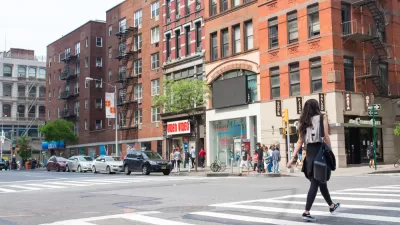Richard Florida interviews Jeff Speck about his new and highly praised book "Walkable City." The two authors discuss why cities should become more walkable to meet the needs of the "Walking Generation."
"The General Theory of Walkability explains how, to attract pedestrians, a place has to provide a walk that is simultaneously useful, safe, comfortable and interesting," says Speck. "This is extraordinarily difficult in most of our (driving) cities, and can only be accomplished when resources are concentrated where they can do the most good, rather than dispersed more evenhandedly across the city, which is the tendency." The cities that are becoming more walkable "understand that their sustainability (economic, health, and environmental) depends on it" and "want to attract and retain young, educated adults." 64 percent of college graduates now decide where they want to live first, and 77 percent want to live in America's urban cores "with ready access to nature, bike lanes, good transit, and street life."
Another related concept is the "Walkability Dividend" in which economist Joe Cortright showed how Portland's "urban growth boundary, coupled with its investments in bike lanes and transit, resulted in a remarkable phenomenon: Portland's per-capita vehicle miles traveled peaked in 1996." Portlanders drive 20 percent less than the national average, resulting in financial and time savings, cleaner air, and slimmer waistlines. From the other side, Speck points out that "[t]he typical American 'working' family now pays more for transportation than for housing" because "so many families found themselves not only underwater on their mortgages but also unable to afford the thirteen car trips per day generated by the average exurban homestead."
In his book Walkable City, Speck reconsiders the agenda he and his co-authors advanced in Suburban Nation. Why invest money and energy in building better suburbs, he says in response to a question from Florida, "when we have hundreds of historic downtown cores with underused infrastructure," "when demographic data tells us that 88 percent of the next 100 million American households will be childless," "when the epidemiologists are telling us that people live longer, healthier lives in cities and towns than in sprawl," and "when the environmentalists are telling us that New Yorkers have one-third the carbon footprint of the typical suburbanite"?
FULL STORY: Toward the Walkable City

Planetizen Federal Action Tracker
A weekly monitor of how Trump’s orders and actions are impacting planners and planning in America.

Restaurant Patios Were a Pandemic Win — Why Were They so Hard to Keep?
Social distancing requirements and changes in travel patterns prompted cities to pilot new uses for street and sidewalk space. Then it got complicated.

Map: Where Senate Republicans Want to Sell Your Public Lands
For public land advocates, the Senate Republicans’ proposal to sell millions of acres of public land in the West is “the biggest fight of their careers.”

Maui's Vacation Rental Debate Turns Ugly
Verbal attacks, misinformation campaigns and fistfights plague a high-stakes debate to convert thousands of vacation rentals into long-term housing.

San Francisco Suspends Traffic Calming Amidst Record Deaths
Citing “a challenging fiscal landscape,” the city will cease the program on the heels of 42 traffic deaths, including 24 pedestrians.

California Homeless Arrests, Citations Spike After Ruling
An investigation reveals that anti-homeless actions increased up to 500% after Grants Pass v. Johnson — even in cities claiming no policy change.
Urban Design for Planners 1: Software Tools
This six-course series explores essential urban design concepts using open source software and equips planners with the tools they need to participate fully in the urban design process.
Planning for Universal Design
Learn the tools for implementing Universal Design in planning regulations.
Heyer Gruel & Associates PA
JM Goldson LLC
Custer County Colorado
City of Camden Redevelopment Agency
City of Astoria
Transportation Research & Education Center (TREC) at Portland State University
Camden Redevelopment Agency
City of Claremont
Municipality of Princeton (NJ)





























